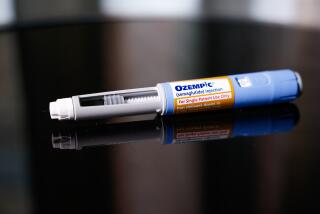When prescribing a drug, doctors have many choices — too many in some cases
- Share via
Nobody wants to be told that he or she has a medical problem that can’t be treated, that there’s no medication that will help. For most common ailments, that’s rarely a problem; the trouble comes instead when it’s time to choose a drug. Sometimes there are just too many choices.
More than 30 drugs are regularly prescribed to control hypertension; more than 20 treat depression. High cholesterol? There are more than 15 medications from which to choose. Even treatment for erectile dysfunction is no longer limited to Viagra.
Doctors and patients usually appreciate having some choice when choosing a prescription; being able to select among drugs helps the physician fine-tune treatment and gives the patient a sense of control.
But having options isn’t always all it’s cracked up to be. Often an obviously “best” choice doesn’t exist.
For starters, many drugs work in nearly identical ways.
Cholesterol-lowering statins — such as atorvastatin (Lipitor), fluvastatin (Lescol), lovastatin (Mevacor), pravastatin (Pravachol), rosuvastatin (Crestor) and simvastatin (Zocor) — all impair the body’s ability to produce cholesterol by blocking a specific enzyme involved in its synthesis.
Antidepressants known as serotonin re-uptake inhibitors — including fluoxetine (Prozac), paroxetine (Paxil), escitalopram (Lexapro), citalopram (Celexa) and sertraline (Zoloft) — are chemically distinct, but they too effectively do the same thing, raising levels of the neurotransmitter serotonin in the brain by blocking its reabsorption.
New medications don’t have to be unique or innovative to receive approval from the Food and Drug Administration.
About 4 out of 5 new drugs provide only minor, if any, therapeutic benefit over existing medications, the agency acknowledges. In fact, some may not even be as good as drugs that are already available.
Even when real differences exist, the evidence to prove which drug is best might not. Studies comparing medications’ effectiveness are performed much less frequently than they should be. In an article appearing earlier this year in the Journal of the American Medical Assn., researchers from the USC Keck School of Medicine and Harvard Medical School reviewed hundreds of drug studies published between June 2008 and September 2009. They found that the majority were designed simply as a steppingstone for FDA approval, comparing the effectiveness of unapproved medications to a placebo or to no treatment at all. Fewer than 1 in 3 studies pitted two or more medications against one another and attempted to discern which was more effective.
Even when research has identified the best drug choice, doctors don’t always prescribe it. “Physicians make many decisions that aren’t evidence-based,” says Dr. Michael Hochman, assistant professor of clinical medicine at USC and lead author of the JAMA article. “Every physician decides a bit differently.” Some physicians can’t keep up with all of the new drug information. Others simply prescribe medications out of habit; they may learn to use one drug during their medical training and, if they have good experiences with it, continue to use it for many years. Still others factor a drug’s cost into their decision-making to help their patients save a bit of money.
Then there’s the pharmaceutical industry. It can affect the choices of doctors and patients.
Many drug companies provide physicians with medication samples, and the availability of these samples can dramatically alter doctors’ prescribing patterns, studies have shown. It can lead physicians, in short, to dispense and prescribe medications that wouldn’t otherwise be their first choice.
Direct-to-consumer advertising of prescription drugs has grown dramatically in recent years, increasing more than threefold since the mid-1990s.
“Pharmaceutical companies try to get patients to ask their doctors for specific products,” says Hochman. And it works. Patients’ requests for specific drugs have a significant effect on what doctors ultimately dispense.
There’s no surefire way to ensure that the best possible medication will always be prescribed. Sorting through the scientific literature and trying to make sense out of drug studies is a daunting task even for physicians; it’s out of the question for most patients. Doctors and patients can approach the decision by working together, with doctors keeping in mind that the most effective medication isn’t always the right choice; some people may find its side effects intolerable or its price tag too high. And patients should be prepared to question their physicians about why they recommended a specific drug.
Sometimes a little research is merited from both parties. Therapeutic guidelines exist for many medical conditions. The National Heart, Lung and Blood Institute, for example, recommends thiazide-type diuretics over other blood pressure medications as initial therapy for most people with hypertension; the American Academy of Pediatrics makes a case for acetaminophen or ibuprofen over antibiotics for ear infections (amoxicillin is recommended over other antibacterial medications when more aggressive treatment is warranted).
When there’s no clear answer, serious consideration should be given to going with what’s tried and true.
“All else being equal, I’d choose the older medication,” says Hochman. “It’s got a longer safety record.” Falling into the trap of believing that newer medications must somehow be better is a huge mistake; frequently they’re just more expensive.
Ultimately, because not everyone responds to medications in exactly the same way, finding the best drug often becomes a process of trial and error. That may not sound like the most appealing approach, but having the option to try more than one medication is actually a good problem to have.
Ulene is a board-certified specialist in preventive medicine practicing in Los Angeles. The M.D. appears once a month.






